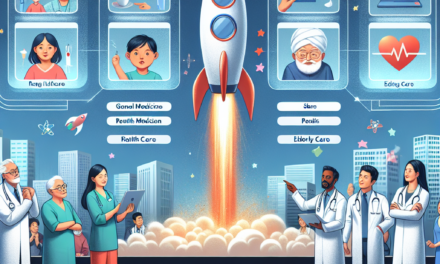Enhancing Healthcare IT Workforce Skills for AI and Cybersecurity Challenges
The healthcare industry is undergoing a significant transformation driven by advancements in technology, particularly in artificial intelligence (AI) and cybersecurity. As healthcare organizations increasingly rely on digital solutions to improve patient care, streamline operations, and protect sensitive data, the demand for a skilled IT workforce has never been greater. This article explores the critical need for enhancing healthcare IT workforce skills to meet the challenges posed by AI and cybersecurity, providing insights into training, best practices, and future trends.
The Importance of AI in Healthcare
Artificial intelligence is revolutionizing healthcare by enabling more accurate diagnoses, personalized treatment plans, and efficient administrative processes. The integration of AI technologies into healthcare systems has the potential to improve patient outcomes significantly. However, to harness the full potential of AI, healthcare IT professionals must possess a robust set of skills.
Understanding AI Technologies
Healthcare IT professionals must have a solid understanding of various AI technologies, including machine learning, natural language processing, and computer vision. These technologies are being used to analyze vast amounts of data, identify patterns, and make predictions that can enhance patient care.
- Machine Learning: This subset of AI involves algorithms that learn from data to make predictions or decisions without being explicitly programmed. In healthcare, machine learning can be used for predictive analytics, such as forecasting patient admissions or identifying high-risk patients.
- Natural Language Processing (NLP): NLP enables computers to understand and interpret human language. In healthcare, NLP can be used to analyze clinical notes, extract relevant information from unstructured data, and improve patient interactions through chatbots.
- Computer Vision: This technology allows computers to interpret and make decisions based on visual data. In healthcare, computer vision can be applied in radiology to assist in diagnosing conditions from medical images.
To effectively implement these technologies, healthcare IT professionals need to engage in continuous learning and training. This includes attending workshops, online courses, and obtaining certifications in AI-related fields. Organizations should also foster a culture of innovation, encouraging their IT workforce to experiment with new technologies and share their findings.
Case Studies of AI Implementation
Several healthcare organizations have successfully implemented AI technologies, showcasing the importance of a skilled IT workforce. For instance, the Mount Sinai Health System in New York has developed an AI algorithm that predicts patient deterioration by analyzing electronic health records (EHRs). This initiative has led to improved patient outcomes and reduced hospital readmission rates.
Another example is the use of AI by the University of California, San Francisco (UCSF) to enhance radiology services. By employing machine learning algorithms to analyze medical images, UCSF has improved diagnostic accuracy and reduced the time required for radiologists to interpret scans.
Challenges in AI Adoption
Despite the promising potential of AI in healthcare, several challenges hinder its widespread adoption. These include data privacy concerns, the need for high-quality data, and the integration of AI systems into existing workflows. Healthcare IT professionals must be equipped to address these challenges by understanding regulatory requirements, ensuring data security, and facilitating seamless integration of AI technologies.
Future Trends in AI and Healthcare
The future of AI in healthcare is bright, with ongoing research and development leading to new applications and innovations. As AI technologies continue to evolve, healthcare IT professionals must stay abreast of emerging trends, such as the use of AI in telemedicine, remote patient monitoring, and personalized medicine. Continuous education and skill enhancement will be crucial for IT professionals to remain relevant in this rapidly changing landscape.
The Role of Cybersecurity in Healthcare
As healthcare organizations increasingly adopt digital technologies, the importance of cybersecurity cannot be overstated. Cyberattacks on healthcare systems can lead to data breaches, financial losses, and compromised patient safety. Therefore, enhancing the cybersecurity skills of the healthcare IT workforce is essential to protect sensitive information and maintain trust in healthcare systems.
Understanding Cybersecurity Threats
Healthcare IT professionals must be well-versed in the various cybersecurity threats that can impact their organizations. Common threats include:
- Ransomware: This type of malware encrypts files and demands payment for their release. Ransomware attacks on healthcare organizations can disrupt operations and compromise patient care.
- Phishing: Cybercriminals often use phishing emails to trick employees into revealing sensitive information or downloading malware. Training staff to recognize phishing attempts is crucial for preventing breaches.
- Insider Threats: Employees with access to sensitive data can pose a significant risk if they misuse their privileges or inadvertently expose information. Implementing strict access controls and monitoring can help mitigate this risk.
To effectively combat these threats, healthcare IT professionals must undergo specialized training in cybersecurity best practices, risk management, and incident response. Organizations should invest in ongoing education and awareness programs to ensure that all staff members understand their role in maintaining cybersecurity.
Case Studies of Cybersecurity in Healthcare
Several healthcare organizations have faced significant cybersecurity challenges, highlighting the need for a skilled IT workforce. For example, the 2015 data breach at Anthem, one of the largest health insurers in the U.S., exposed the personal information of nearly 80 million individuals. This incident underscored the importance of robust cybersecurity measures and the need for continuous training for IT staff.
Another notable case is the 2020 ransomware attack on Universal Health Services (UHS), which disrupted operations across its facilities. The attack highlighted vulnerabilities in healthcare systems and the critical need for healthcare IT professionals to be prepared for such incidents.
Best Practices for Cybersecurity Training
To enhance the cybersecurity skills of the healthcare IT workforce, organizations should implement best practices for training and awareness. These include:
- Regular Training Sessions: Conducting regular training sessions on cybersecurity topics, including threat detection, incident response, and data protection, can help keep staff informed and prepared.
- Simulated Phishing Exercises: Running simulated phishing exercises can help employees recognize and respond to phishing attempts, reducing the likelihood of successful attacks.
- Incident Response Drills: Conducting incident response drills can prepare IT staff to respond effectively to cybersecurity incidents, minimizing potential damage.
By fostering a culture of cybersecurity awareness and providing ongoing training, healthcare organizations can significantly reduce their risk of cyberattacks and protect sensitive patient information.
The Future of Cybersecurity in Healthcare
The future of cybersecurity in healthcare will be shaped by emerging technologies and evolving threats. As healthcare organizations continue to adopt cloud computing, IoT devices, and telehealth solutions, the attack surface for cybercriminals will expand. Healthcare IT professionals must stay informed about the latest cybersecurity trends and technologies, such as artificial intelligence for threat detection and blockchain for secure data sharing.
Moreover, regulatory requirements surrounding data protection, such as the Health Insurance Portability and Accountability Act (HIPAA) in the U.S., will continue to evolve. Healthcare IT professionals must be prepared to navigate these regulations and ensure compliance while implementing effective cybersecurity measures.
Building a Skilled Healthcare IT Workforce
To address the challenges posed by AI and cybersecurity, healthcare organizations must prioritize building a skilled IT workforce. This involves not only enhancing existing skills but also attracting new talent to the field.
Identifying Skill Gaps
Healthcare organizations should conduct a thorough assessment of their IT workforce to identify skill gaps related to AI and cybersecurity. This assessment can involve evaluating current staff competencies, analyzing job descriptions, and comparing them to industry standards. By understanding where gaps exist, organizations can develop targeted training programs to address these deficiencies.
Developing Training Programs
Once skill gaps have been identified, organizations should develop comprehensive training programs that focus on both AI and cybersecurity. These programs can include:
- Workshops and Seminars: Hosting workshops and seminars led by industry experts can provide valuable insights into the latest trends and best practices in AI and cybersecurity.
- Online Courses: Offering access to online courses and certifications can enable IT professionals to learn at their own pace and gain recognized credentials in their areas of interest.
- Mentorship Programs: Establishing mentorship programs can facilitate knowledge sharing between experienced professionals and those new to the field, fostering a culture of continuous learning.
By investing in training and development, healthcare organizations can ensure that their IT workforce is equipped with the skills needed to navigate the complexities of AI and cybersecurity.
Attracting New Talent
In addition to enhancing the skills of existing staff, healthcare organizations must also focus on attracting new talent to the IT workforce. This can be achieved through:
- Partnerships with Educational Institutions: Collaborating with universities and technical schools can help create a pipeline of skilled graduates who are prepared to enter the healthcare IT workforce.
- Internship Programs: Offering internship programs can provide students with hands-on experience in healthcare IT, making them more attractive candidates for full-time positions.
- Promoting Career Opportunities: Actively promoting career opportunities within the organization can help attract individuals who are passionate about using technology to improve healthcare.
By taking a proactive approach to talent acquisition, healthcare organizations can build a diverse and skilled IT workforce capable of addressing the challenges posed by AI and cybersecurity.
Creating a Culture of Innovation
To foster a skilled healthcare IT workforce, organizations must create a culture of innovation that encourages continuous learning and experimentation. This can involve:
- Encouraging Collaboration: Promoting collaboration between IT staff and other departments can lead to innovative solutions that enhance patient care and operational efficiency.
- Recognizing Achievements: Acknowledging and rewarding employees for their contributions to innovation can motivate staff to pursue new ideas and technologies.
- Providing Resources: Allocating resources for research and development can empower IT professionals to explore new technologies and implement them within the organization.
By fostering a culture of innovation, healthcare organizations can ensure that their IT workforce remains agile and responsive to the evolving landscape of AI and cybersecurity.
Conclusion
The integration of AI and the increasing importance of cybersecurity present both challenges and opportunities for the healthcare industry. To navigate this complex landscape, healthcare organizations must prioritize enhancing the skills of their IT workforce. By investing in training, developing comprehensive programs, and fostering a culture of innovation, organizations can equip their IT professionals with the knowledge and skills needed to leverage AI technologies and protect against cybersecurity threats.
As the healthcare industry continues to evolve, the demand for skilled IT professionals will only grow. By taking proactive steps to enhance workforce skills, healthcare organizations can ensure that they are well-prepared to meet the challenges of the future while delivering high-quality patient care.





